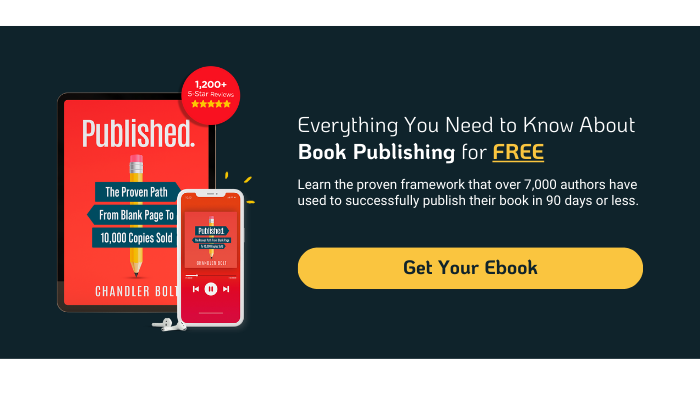Want to become a successful author as soon as possible? You need to learn what are the most popular book genres on Amazon.
An increasingly enormous volume of readers do most or all of their reading through their Kindle. And this makes sense—eBooks are cheaper than physical copies, they don’t take up physical space in your house, and you can download them in a matter of minutes instead of going to a store to buy them or waiting for them to be shipped to your home.
Ebooks are especially helpful for self-published authors looking to save a little money on the production of their book. Authors still need to hire a formatter and cover artist (unless they can do it themselves), but generally, it’ll be a bit cheaper for an eBook than for a physical copy. Additionally, self-published authors usually get a higher cut of their royalties from eBooks than they might from physical copies.
Oh, and one more thing: if you figure out the most popular genres and categories on Amazon, you can make your book a bestseller and get ahead of trends to maximize your sales.
How? That’s what we’re here to talk about today! In this article, we’ll cover which book genres and categories are most popular on Amazon, how you can find this information for yourself, and how you can use this information to build a full-time career as a self-published author.
This guide to the most popular book genres on Amazon covers:
- The most popular book genres on Amazon
- Popular fiction genres
- Popular nonfiction genres
- Book categories
- How to find the most popular book genres
- Writing to market
- Tips on how to use trends
The most popular book genres on Amazon
What’s the most popular book genre on Amazon? Well, it’s a little complicated.
Amazon uses categories to sort their books, and there’s over 16,000 of them, which means they get pretty niche (we’ll talk more about categories in a minute). However, you can still search for books on Amazon by genre, and you can also navigate to the Amazon Bestseller Chart to see which books are most popular right now (though this doesn’t tell you which genres, on the whole, are selling the most books).
Finding the most popular book genres takes some research.
After investigating, the twelve most popular fiction genres on Amazon are:
- Fantasy
- Science Fiction
- Dystopian
- Adventure
- Romance
- Detective & Mystery
- Horror
- Thriller
- LGBTQ+
- Historical Fiction
- Young Adult (YA)
- Children’s Fiction
What about nonfiction? The eighteen most popular nonfiction genres on Amazon are:
- Memoir & Autobiography
- Biography
- Cooking
- Art & Photography
- Self-Help/Personal Development
- Motivational/Inspirational
- Health & Fitness
- History
- Crafts, Hobbies & Home
- Families & Relationships
- Humor & Entertainment
- Business & Money
- Law & Criminology
- Politics & Social Sciences
- Religion & Spirituality
- Education & Teaching
- Travel
- True Crime
Most popular book categories
Categories are like subgenres, and they’re vital to understand and utilize if you want to up your Amazon sales.
Categories function as keywords and search terms as well as subgenres, which means that the algorithm will use them to recommend similar books to readers. These can get incredibly niche, and there’s no way to see a complete list of every category Amazon has to offer, let alone a list of sales figures. This means you have to do a bit of sleuthing to figure out which categories are currently selling the most copies on the site.
The 20 most popular Kindle Store Categories are:
- Romance > Contemporary
- Literature & Fiction > Contemporary Fiction > Women
- Romance > New Adult & College
- Literature & Fiction > Contemporary Fiction > Romance
- Literature & Fiction > Women > Romance
- Literature & Fiction > Genre Fiction > Coming of Age
- Romance > Mystery & Suspense > Suspense
- Science Fiction & Fantasy > Fantasy > Paranormal & Urban
- Literature & Fiction > Genre Fiction > Erotica
- Literature & Fiction > Women > Mystery, Thriller & Suspense > Women Sleuths
- Romance > Romantic Comedy
- Literature & Fiction > Literary Fiction > Literary
- Literature & Fiction > Contemporary Fiction > Literary
- Literature & Fiction > Genre Fiction
- Science Fiction & Fantasy > Fantasy > Epic
- Romance > Fantasy
- Romance > Paranormal > Werewolves & Shifters
- Romance > Holidays
- Mystery, Thriller & Suspense > Mystery > Police Procedurals
- Literature & Fiction > Humor & Satire > General Humor
How to find most popular book genres
If you want to take a look at the bestselling books on Amazon right now, here’s how to find them.
Step One: Open Amazon and navigate to ‘Best Sellers.’
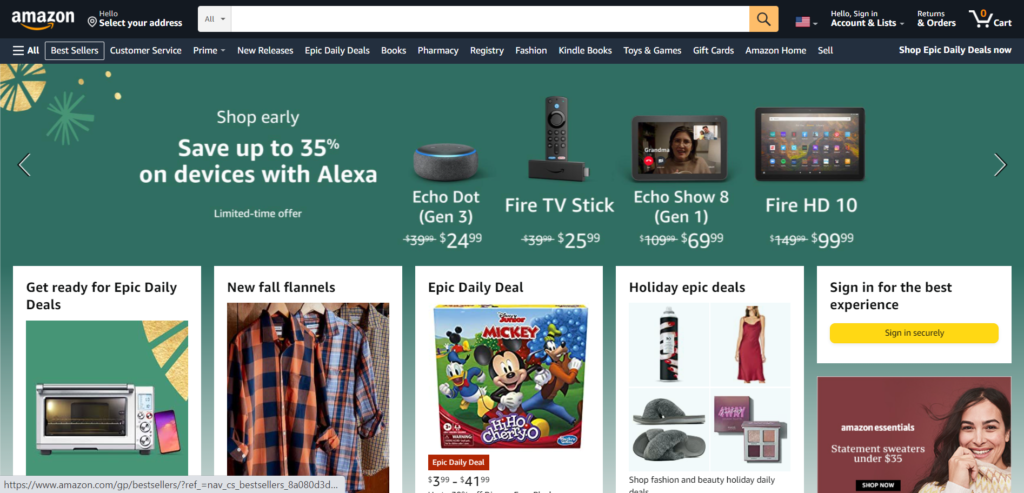
Step Two: On the left hand side of the screen, you’ll see a ribbon listing a ton of categories. Scroll down, find Kindle Store, and click on it.
Step Three: You should be looking at Amazon’s ‘Best Sellers in Kindle Store’ page. You can click on a book to see its listing, which is what we’re going to do next. For this example, I’m going to click on The Keeper of Happy Endings by Barbara Davis.
You’ll also see, on the left-hand side, a few options for sorting these results. This includes Newsstand, nonfiction, short reads, and Prime Reading—feel free to click around and explore different results for different types of reading.
When I click on The Keeper of Happy Endings, here’s what comes up:
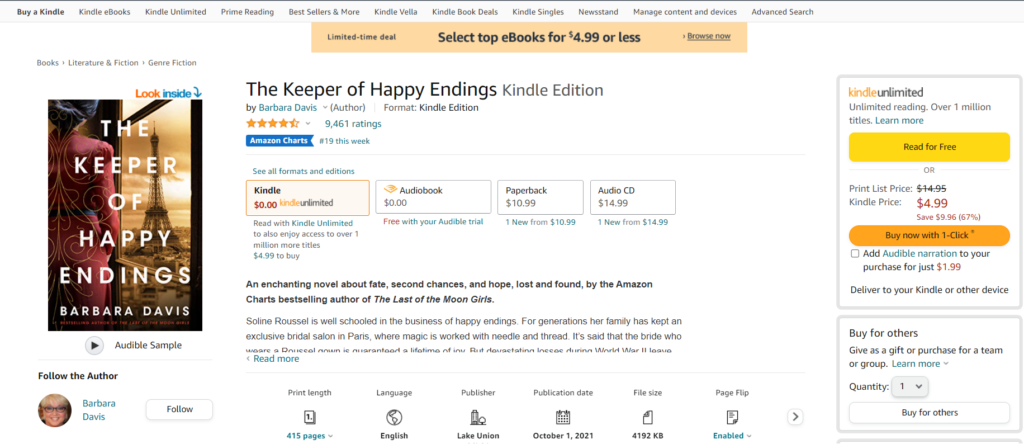
Step Four: See the writing above the book? This lists the category as Books > Literature & Fiction > Genre Fiction. These categories are listed by most broad to most specific. The type of item is a book, and the type of book is literature and fiction—more specifically, genre fiction.
There’s a few things we can do from here to gather more information about this book’s categories and other books in those categories.
Step Five: Scroll down to Product Details. This will give you a bunch of information about the book, but we’re looking for Best Sellers Rank. Here, we see the book is ranked #4 in the Kindle Store, and we see it’s ranked #1 in Historical Literary Fiction, World War II Historical Fiction (Books), and Historical French Fiction.
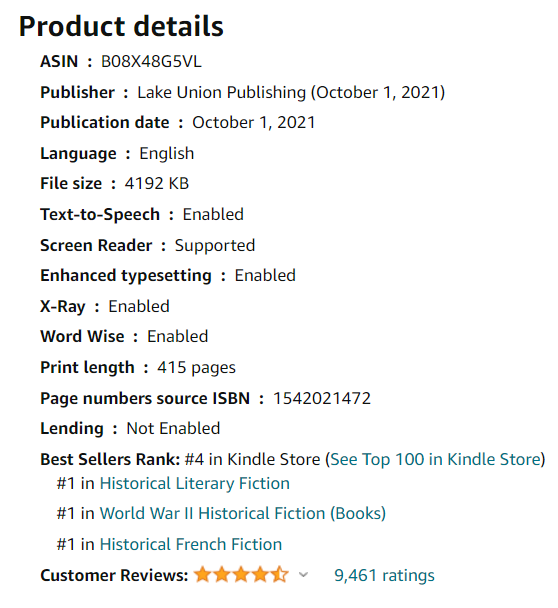
Clicking on any of these categories will take you to the bestseller pages for that specific category. For example, clicking on Historical Literary Fiction will show you the bestselling books listed under that category. This helps you see what’s selling in more specific categories, so you’re not trying to narrow it down from just ‘books.’
But let’s scroll back up to the book’s listing, where it says Books > Literature & Fiction > Genre Fiction and try finding more categories a different way.
Step Six: Once you’ve scrolled back up and found Books > Literature & Fiction > Genre Fiction, click on Genre Fiction.
You should have a page that looks something like this:
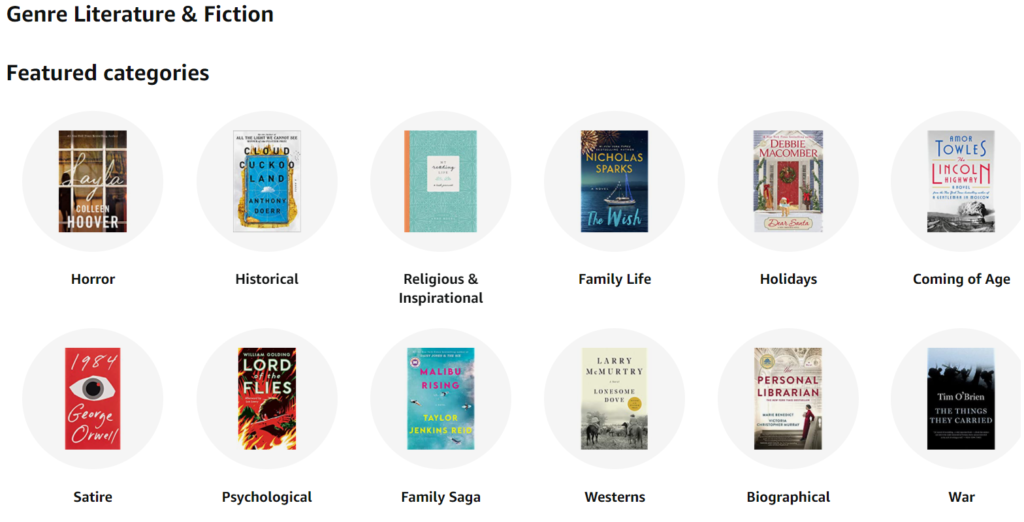
Underneath ‘featured categories,’ we get a list of categories to investigate. If you scroll over these categories, a scroll will offer more specific subcategories. For example, here’s what happens when I hover over the ‘Historical’ category:
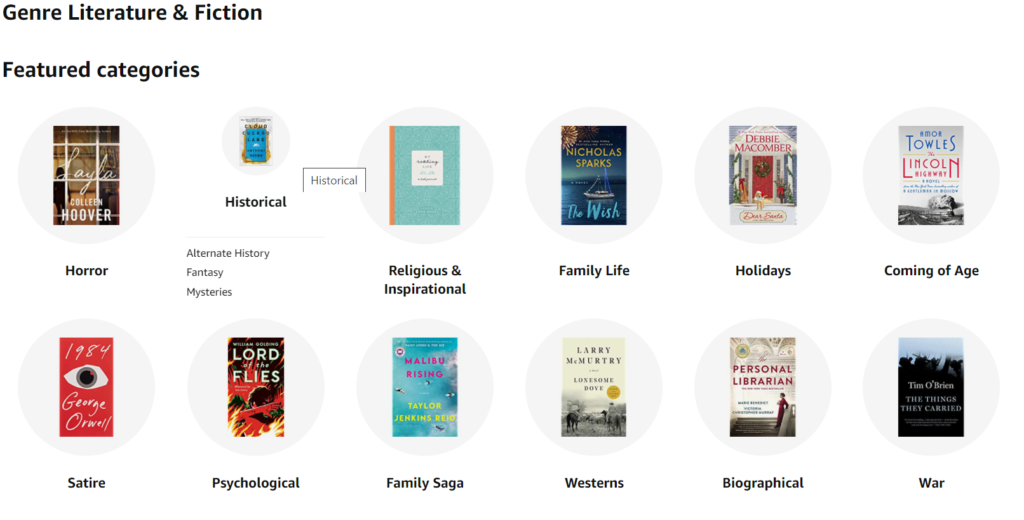
If I click on this, it takes me to a page filled with categories listed under ‘Historical.’
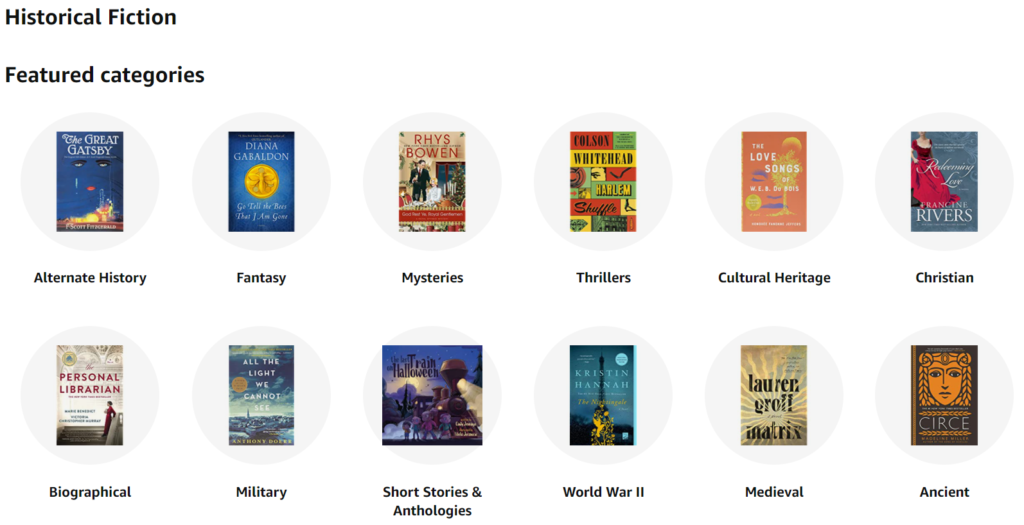
You can click on any of the icons to see bestseller lists in these categories, or you can navigate to the left-hand side to search for more specific results.
Writing to market using popular genres
Writing to market, plainly put, is writing books based on what’s popular right now.
Let’s use Twilight as an example. Twilight, when it came out, absolutely dominated the young adult romance market. Immediately after it surged in popularity, a ton of Twilight look-alikes started taking to the shelves. In some bookstores, this led to the invention of the ‘paranormal teen romance’ category—Twilight revealed a huge market for a certain category of story, and authors were quick to capitalize.
The most obvious con to adopting a write-to-market strategy is that publishing is a very, very slow process. It can take years to publish a book, and by that time, maybe no one cares about teen vampire romance anymore. Maybe it’s become cliche or cringe-worthy by the time your book comes out. And if you’re writing stories purely to hitch on to what’s popular, without any passion for the story itself, it’s going to be a slog.
This doesn’t mean write-to-market doesn’t work, though—the invention of the ‘paranormal teen romance’ category proves that it definitely does. But how do you try this without burning out or falling behind?
First, eBook publications happen much more quickly than their physical counterparts. A self-published romance author might publish six books a year. This fast turnaround means authors can stay on top of trends before they fall out of fashion.
Second, it’s important to write books you do care about. And I don’t just say that because I have some really sappy feelings about art—again, writing books is difficult, and it’s going to be like pulling teeth if you don’t care about the story. Come up with story ideas you genuinely like in the categories currently doing well. They don’t have to match beat-for-beat with trendsetting books. They just need to appeal to readers looking for similar experiences.
With all that said, let’s look at a few ways writing to market can help you.
Fast track to full time
Perhaps most importantly, writing to market can help you start your full-time writing career more quickly.
And this makes sense—if you’re targeting your publications based on what’s popular, you’ve got a better chance at selling books.
It’s difficult for some to hear, but writing is, in fact, a business, and your book is a product. It’s easier to sell that product when there’s a demand for it, and writing to market means you’re directly targeting that demand.
Tips for using trends for your next book
I mentioned earlier that you don’t have to pick story ideas solely because they’re trending, but what exactly does that mean? How can you create stories that you genuinely care about while still keeping an ear to the ground for upcoming trends? Here are a few tips to help you avoid burnout and keep your own writing interesting and personal for you.
Use trends for inspiration
Instead of forcing yourself to come up with stories that fall under bestselling categories, use those categories to inspire stories you’re excited about. And, ultimately, if nothing speaks to you, write the story you want to write—if you have a story in a genre that isn’t currently hot, you don’t need to throw it out! Keep it tucked somewhere and wait for the right time to release it. It’s almost guaranteed that the market will come back around, and when the timing is right, you can release it to an eager audience.
Be a versatile, fast writer
“But wait,” you’re thinking. “I wrote my book, and you’re saying I just can’t publish anything until hopefully, one day, my genre is the next big thing?”
Not necessarily.
If you want to maximize your Amazon profits as a self-published author, you’ll need to have a pretty quick turnaround.
Remember what I said earlier about eBooks enabling self-published authors to publish work more frequently? Using that to your advantage is going to make a world of difference for your career.
Even more importantly, you should work on stories in different categories. Maybe your genre is romance, and you are absolutely not interested in writing in a different genre. That’s fine! Try working in different subgenres of romance. Maybe you’ve got a historical romance series, a contemporary small-town romance series, and a sci-fi romance series brewing.
This will diversify your readership, which means more readers for more subgenres. Second, it’s going to increase your chances of working within a trending category.
Choose categories for your book, not vice versa
Finally, it’s important to remember that categories are functionally search tools. If you get to the top of a bestseller list in a niche category, this can help boost your book in Amazon’s algorithm. If you list your book under a popular category, you’ll benefit from all the traffic that category gets. This means that you should ultimately be picking categories with site traffic in mind.
Obviously, you don’t want to lie. Don’t list your book as a contemporary small-town romance if it’s definitely not. But keep an eye on examples and lists like the ones shown above and see which categories you can apply to your book’s listing to improve its visibility on the site.
Want to learn more about Self-Publishing School book coaches?
If you have additional questions, or need additional resources, book a call with our Resource Team.
Our team can give you extra resources to help you on your author journey, learn about your book and your book goals.
If you’re interested in learning more about how Self-Publishing School can help you write, publish, and market your books (or sell more books if you’re published already), they can schedule a call with one of our Publishing Success Strategists for you.
Your Success Strategist will ask questions about your book to understand if you’re a good fit for our programs and explain what we offer at Self-Publishing School. You’ll learn about our tailored courses, writing groups, mastermind community, and our amazing book coaches.
With one of the highest success rates in the industry (for an online school plus coaching and accountability program), we want to make sure that you are paired with the right coach and program for your book, or we’ll recommend other resources for you.
Curious, but not ready to book a call yet? No problem!
Check out the free online class below to learn more about how we started, mind map your book in real time (during the class), and learn the steps of self-publishing!
